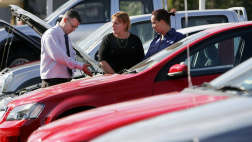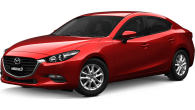The phone rings and the bloke on the other end asks for Lisa. There's no Lisa at my place, but he didn't know that, so I said "speaking". Obviously, I'm not Lisa. I'm not even female. But for a second, he baulked. He had doubts about his question and doubts can be dangerous.
Like the time I suggested a friend look at a Honda Accord Euro as a potential purchase. My friend came back to me happy with the car he bought. But it wasn't an Accord Euro, it was an Accord. These are both cars but they're quite different and shouldn't be mixed up. Like Lisa and Neil. So be very careful what you ask for.
Design
The Accord Euro is subjectively Honda's prettiest sedan. It's now in its second generation and though bigger, retains the neatly creased panels and compact dimensions. It's a four seater - three children in the back is okay - with reasonable leg and headroom and a decent boot with split fold-down rear seats and a full-size spare under the floor.
The cabin in the cheapest Euro, tested here, is attractive in an simplistic way but has to much black and charcoal-coloured plastic to lift the spirits. Yes, it's a nice-looking and inoffensive car but, like the Corolla, can be invisible in the traffic.
Value
Honda's Euro was always seen as a premium product with a high price but the $31,490 entry price for the base manual here is a really good deal. It's only about a grand off the Thai-made Civic. The price this month was dropped by $2000 and it immediately lifts the Euro up the shopping list. This is one of the few Hondas made in Japan - the others are from the UK or Thailand - so there's a perception of quality. But that wasn't necessarily the case.
Standard gear is very good, starting with the safety of six airbags and stability control. Comfort features include trip computer, cruise control, iPod-friendly six-CD audio with 10 speakers, dual-zone climate airconditioning and excellent personal storage areas.
It's up against the Mazda6, Hyundai i45, Toyota Camry and Skoda Octavia - amongst others - though its price and compact dimensions also make it appeal to prospective buyers of the Mitsubishi Lancer, Mazda3 and Subaru Impreza.
Technology
Honda's variable-valve system gives the engine a wide power range and only harms fuel economy when you live in the upper reaches of the tachometer's dial. This beautifully made and fuss-free engine is a tad complex and that accounts for the wallet-lightening 10,000km service intervals - rivals are generally 15,000km - and expensive liquid diet of premium-grade fuel.
The Euro is traditional in its design, departing off the beaten track ever-so slightly with double wishbone suspension. The retention of a full-size spare wheel and the fact it makes minimal difference to boot space shows clever thinking.
Driving
There's no solid thunk when the doors close and the boot rattles when slammed. That's not a great look and jarring compared with the superior door action of the $19,000 Volkswagen Polo I had driven just prior. On the road, the electrically-assisted steering is vague around the straight-ahead position and hesitates for a fraction when turning off centre - all a bit disconcerting. But the ride comfort and quietness is excellent, as is the handling (steering aside) and the willingness of the engine.
Typically of the class, the more people you stuff inside the cabin the more the performance suffers. But given this is a two-person or one adult, two kids type of car, it's not a problem. I love the manual gearshift - even knowing most of you will opt for the automatic - for its crisp changes and the way the six ratios make the most of the engine's delivery. Perhaps I was too light on the accelerator because my 8.1 litres/100km average was well down on Honda's claimed 8.9 l/100km.
Verdict
It's simple but sensible and elevates itself because it's a nice drive with a keen price.
Honda Accord Euro 2010: Euro
| Engine Type | Inline 4, 2.4L |
|---|---|
| Fuel Type | Premium Unleaded Petrol |
| Fuel Efficiency | 8.9L/100km (combined) |
| Seating | 5 |
| Price From | $7,590 - $10,670 |
Pricing Guides





.jpg)
.jpg)













.png)



.jpg)




.jpg)

Comments